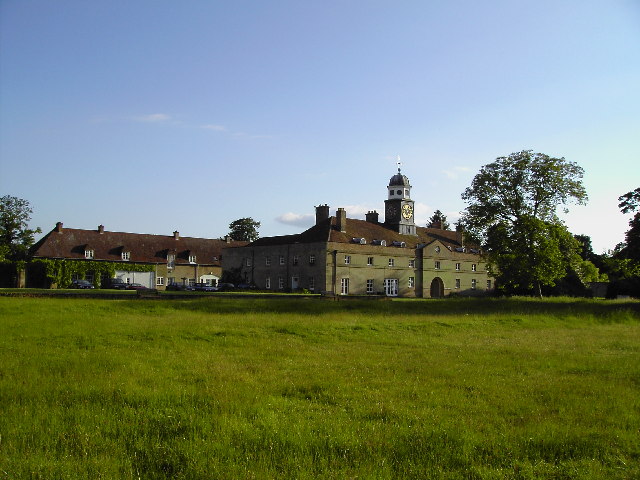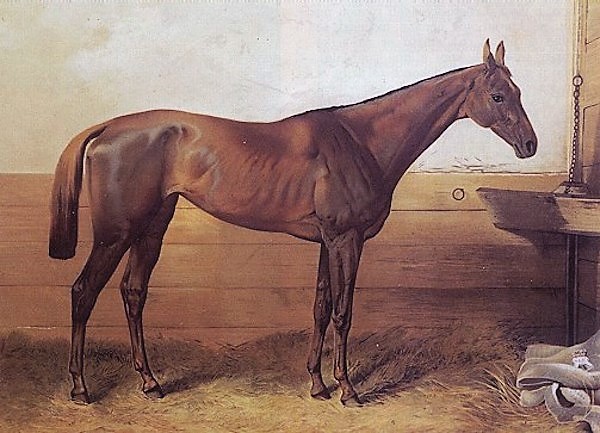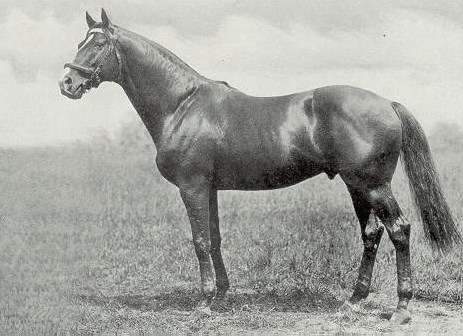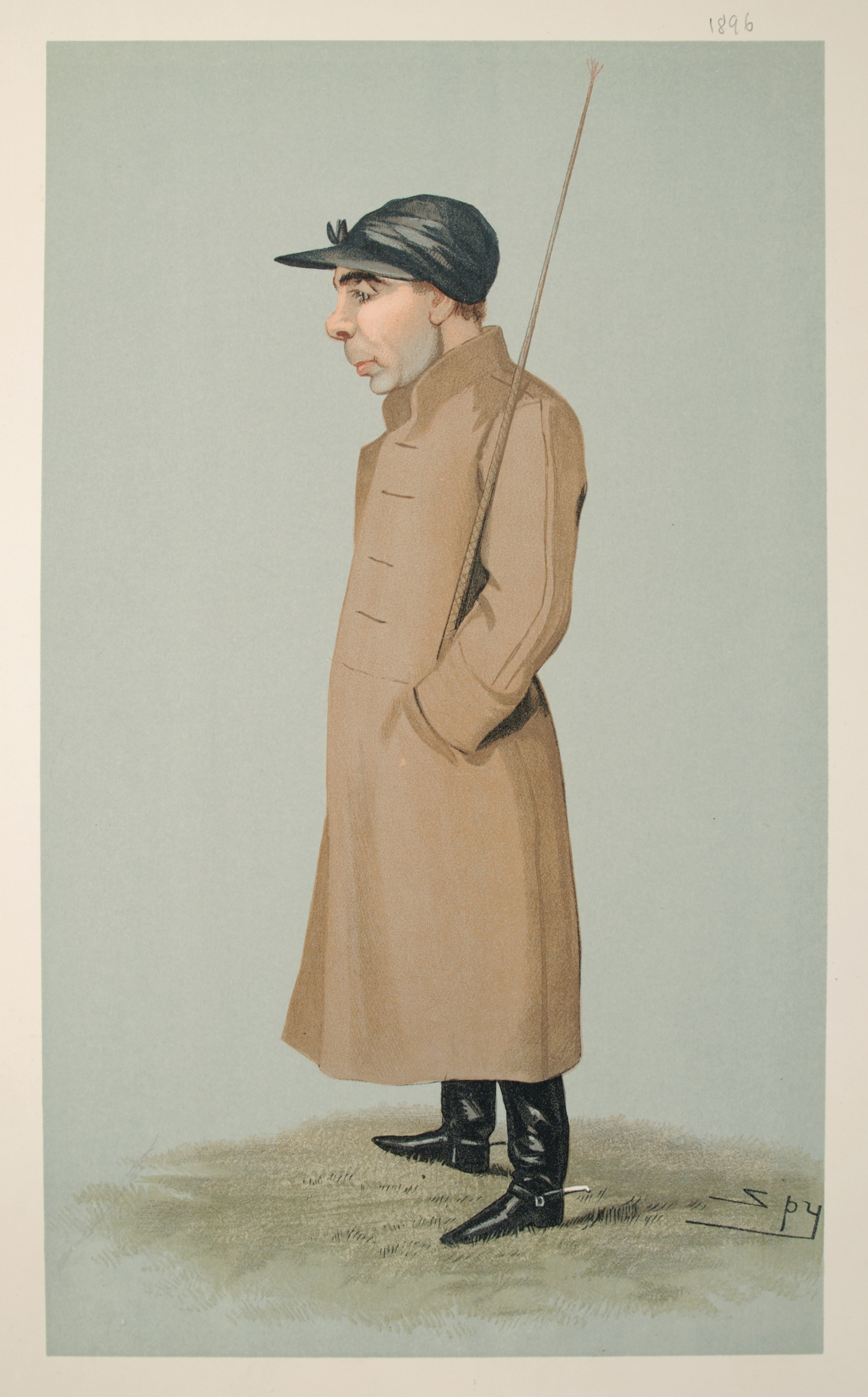|
Barcaldine (horse)
Barcaldine (1878) was an outstanding, undefeated British Thoroughbred racehorse and sire. He succeeded in carrying on the Matchem sire-line, which would have died out in Europe without his sons and grandsons. In the US, Matchem passed on his sire-line through Man o' War via the exported Australian.Leicester, Sir Charles, “Bloodstock Breeding”, J.A. Allen & Co, London, 1969 Pedigree Barcaldine was inbred (2x3), being by Solon (by the Triple Crown winner West Australian from Darling’s Dam). His dam, Ballyroe, was by Belladrum from Bon Accord by Adventurer from Darling’s Dam. Racing record Two-year-old season Barcaldine had four starts for four wins as a two-year-old: in September the Railway Stakes at the Curragh Racecourse, the National Produce Stakes which he won by four lengths carrying 9 stone (126 pounds), the Beresford Stakes of one mile carrying and the Paget Stakes of six furlongs, carrying or 59 kg). [...More Info...] [...Related Items...] OR: [Wikipedia] [Google] [Baidu] |
Barcaldine (GB)
Barcaldine may refer to: Australia * Barcaldine, Queensland, Australia **Barcaldine Airport, Queensland Australia * Barcaldine Region, a local government area in Queensland, Australia ** Shire of Barcaldine, a former local government area in Queensland, Australia United Kingdom *Barcaldine (horse), a British Thoroughbred racehorse *Barcaldine, Argyll Barcaldine ( gd, Am Barra Calltainn) is a small settlement in Scotland centred on the historic Barcaldine House and located on the banks of Loch Creran between Oban and Ballachulish. There was formerly a railway station here. Barcaldine Castle ..., Scotland, United Kingdom {{disambiguation ro:Barcaldine ... [...More Info...] [...Related Items...] OR: [Wikipedia] [Google] [Baidu] |
Godolphin Arabian
The Godolphin Arabian (–1753), also known as the Godolphin Barb, was an Arabian horse who was one of three stallions that founded the modern Thoroughbred (the others were the Darley Arabian and the Byerley Turk). He was named after his best-known owner, Francis Godolphin, 2nd Earl of Godolphin. Origins The Godolphin Arabian was foaled about 1724 in Yemen and moved several times before reaching England. At some early age, he was exported, probably via Syria, to the stud of the bey of Tunis. From there he was given to Louis XV of France in 1730. It is believed he was a present from monarch to monarch. Not valued by his new French owner, it is believed he was used as a carthorse. The horse was then imported from France by Edward Coke and sent to his stud at Longford Hall, Derbyshire, where he remained until the death of his owner in 1733. He was bequeathed to Roger Williams, "proprietor of the St. James's Coffee House", who inherited Coke's stallions. He was bought by the 2 ... [...More Info...] [...Related Items...] OR: [Wikipedia] [Google] [Baidu] |
List Of Leading Thoroughbred Racehorses
The list of leading Thoroughbred racehorses contains the names of undefeated racehorses and other horses that had an outstanding race record in specific categories. Note though that many champions do not appear on the list as an unexpected defeat may be caused by many factors such as injury, illness, going, racing tactics and differences in weight carried, the latter being particularly significant in North America and Australia where handicaps are common even at the highest level of racing. It is common to compare racehorses on multiple factors such as their overall race record, the quality of the horses they beat and the brilliance of their wins. Comparison of raw times is generally unreliable between horses of different eras or even over different racecourses due to a variety of factors such as the racing surface and the pace at which the race is run. Timeform ratings, introduced in 1948, and Beyer Speed Figures, introduced in the United States in 1992, are relatively recent ... [...More Info...] [...Related Items...] OR: [Wikipedia] [Google] [Baidu] |
South America
South America is a continent entirely in the Western Hemisphere and mostly in the Southern Hemisphere, with a relatively small portion in the Northern Hemisphere at the northern tip of the continent. It can also be described as the southern Subregion#Americas, subregion of a single continent called Americas, America. South America is bordered on the west by the Pacific Ocean and on the north and east by the Atlantic Ocean; North America and the Caribbean Sea lie to the northwest. The continent generally includes twelve sovereign states: Argentina, Bolivia, Brazil, Chile, Colombia, Ecuador, Guyana, Paraguay, Peru, Suriname, Uruguay, and Venezuela; two dependent territory, dependent territories: the Falkland Islands and South Georgia and the South Sandwich Islands; and one administrative division, internal territory: French Guiana. In addition, the ABC islands (Leeward Antilles), ABC islands of the Kingdom of the Netherlands, Ascension Island (dependency of Saint Helena, Asce ... [...More Info...] [...Related Items...] OR: [Wikipedia] [Google] [Baidu] |
Australia
Australia, officially the Commonwealth of Australia, is a sovereign ''Sovereign'' is a title which can be applied to the highest leader in various categories. The word is borrowed from Old French , which is ultimately derived from the Latin , meaning 'above'. The roles of a sovereign vary from monarch, ruler or ... country comprising the mainland of the Australian continent, the island of Tasmania, and numerous smaller islands. With an area of , Australia is the largest country by area in Oceania and the world's sixth-largest country. Australia is the oldest, flattest, and driest inhabited continent, with the least fertile soils. It is a megadiverse country, and its size gives it a wide variety of landscapes and climates, with deserts in the centre, tropical Forests of Australia, rainforests in the north-east, and List of mountains in Australia, mountain ranges in the south-east. The ancestors of Aboriginal Australians began arriving from south east Asia approx ... [...More Info...] [...Related Items...] OR: [Wikipedia] [Google] [Baidu] |
Leading Sire In Great Britain & Ireland
The title of champion, or leading, sire of racehorses in Great Britain and Ireland is awarded to the stallion whose offspring have won the most prize money in Britain and Ireland during the flat racing season. The current champion is Frankel, who replaced his sire Galileo as the leading sire in 2021 after Galileo had won the title twelve times. Unlike the similar title for leading sire in North America, the stallion in question does not need to have resided in Great Britain or Ireland during his stud career, although the vast majority have done so. Northern Dancer is the most notable example of a North American-based stallion who won this title. The Northern Dancer sire line has dominated the list for the last several decades, mostly through his son Sadler's Wells (14 titles) and grandson Galileo. Records Most championships: * 14 – Sadler's Wells – ''1990, 1992–2004'' * 13 – Highflyer – ''1785–1796, 1798'' * 12 – Galileo – ''2008, 2010–2020'' * 10 – Sir ... [...More Info...] [...Related Items...] OR: [Wikipedia] [Google] [Baidu] |
Stud (animal)
A stud animal is a registered animal retained for breeding. The terms for the male of a given animal species (stallion, bull, rooster, etc.) usually imply that the animal is intact—that is, not castrated—and therefore capable of siring offspring. A specialized vocabulary exists for de-sexed animals (gelding, steer, etc.) and those animals used in grading up to a purebred status. Stud females are generally used to breed further stud animals, but stud males may be used in crossbreeding programs. Both sexes of stud animals are regularly used in artificial breeding programs. A stud farm, in animal husbandry, is an establishment for selective breeding using stud animals.Taylor, Peter, Pastoral Properties of Australia, George Allen & Unwin, Sydney, London, Boston,1984 This results in artificial selection. Stud fees A stud fee is a price paid by the owner of a female animal, such as a horse or a dog, to the owner of a male animal for the right to breed to it. Service fees can ... [...More Info...] [...Related Items...] OR: [Wikipedia] [Google] [Baidu] |
Hurry On
Hurry On (7 May 1913 – 1936) was an undefeated British Thoroughbred racehorse and sire that revived the Matchem sire line.Leicester, Sir Charles, "Bloodstock Breeding", J.A. Allen & Co, London, 1969 English trainer Fred Darling called Hurry On the best horse he ever trained. Breeding Hurry On was by Marcovil, who won two races and was an ordinary sire. His dam was the unraced Toute Suite by Sainfoin, who sired English Triple Crown winner Rock Sand. Marcovil was inbred to Hermit in the 3rd remove.Pryor, Peter, ''The Classic Connection'', Cortney Publications, Luton, 1979 Hurry On cost his Scotch whisky producer owner James Buchanan, later Baron Woolavington, 500 guineas as a yearling. He was a late colt, having been foaled on 7 May, but he matured into a 17 hands high horse. Racing record As he was a backward late colt, Hurry On was not raced as a two-year-old and was not entered in The Derby. He was undefeated in all of his six three-year-old starts, ranging in distan ... [...More Info...] [...Related Items...] OR: [Wikipedia] [Google] [Baidu] |
Epsom Derby
The Derby Stakes, also known as the Epsom Derby or the Derby, and as the Cazoo Derby for sponsorship reasons, is a Group 1 flat horse race in England open to three-year-old colts and fillies. It is run at Epsom Downs Racecourse in Surrey on the first Saturday of June each year, over a distance of one mile, four furlongs and 6 yards (2,420 metres). It was first run in 1780. It is Britain's richest flat horse race, and the most prestigious of the five Classics. It is sometimes referred to as the "Blue Riband" of the turf. The race serves as the middle leg of the historically significant Triple Crown of British horse racing, preceded by the 2000 Guineas and followed by the St Leger, although the feat of winning all three is rarely attempted in the modern era due to changing priorities in racing and breeding, and the demands it places on horses. The name "Derby" (deriving from the sponsorship of the Earl of Derby) has been borrowed many times, notably by the Kentu ... [...More Info...] [...Related Items...] OR: [Wikipedia] [Google] [Baidu] |
St Leger Stakes
The St Leger Stakes is a Group 1 flat horse race in Great Britain open to three-year-old thoroughbred colts and fillies. It is run at Doncaster over a distance of 1 mile, 6 furlongs and 115 yards (2,921 metres), and it is scheduled to take place each year in September. Established in 1776, the St Leger is the oldest of Britain's five Classics. It is the last of the five to be run each year, and its distance is longer than any of the other four. The St Leger is the final leg of the English Triple Crown, which begins with the 2000 Guineas and continues with the Derby. It also completes the Fillies' Triple Crown, following on from the 1000 Guineas and the Oaks. The St Leger has rarely featured Triple Crown contenders in recent decades, with the only one in recent years being the 2012 2,000 Guineas and Derby winner Camelot, who finished second in the St Leger. History Early years ... [...More Info...] [...Related Items...] OR: [Wikipedia] [Google] [Baidu] |
Sir Visto
Sir Visto (1892–1914) was a British Thoroughbred racehorse and sire. In a career that lasted from 1894 to 1896 he ran thirteen times and won three races. As a three-year-old in the 1895 he won both The Derby and the St Leger at Doncaster. He failed to win in six subsequent races and was retired to stud at the end of the 1896 season. Background Sir Visto was described as “a lengthy, rather plain bay with sickle hocks”, but an excellent mover. He was also described as looking powerful but "unfurnished" and "split-up". He was bred at the Crafton Stud by his owner Lord Rosebery, a prominent Liberal statesman who became Prime Minister in 1894. Sir Visto's St Leger was the last of twenty-eight classic wins gained by his trainer Mathew Dawson. Dawson, who was over seventy at the time had "retired" from large-scale training in 1885, but continued to handle a small number of horses at his Melton House Stable. Sir Visto's sire was the undefeated Irish champion Barcaldine, a ... [...More Info...] [...Related Items...] OR: [Wikipedia] [Google] [Baidu] |
Ascot Gold Cup
The Gold Cup is a Group 1 flat horse race in Great Britain open to horses aged four years or older. It is run at Ascot over a distance of 2 miles 3 furlongs and 210 yards (4,014 metres), and it is scheduled to take place each year in June. It is Britain's most prestigious event for "stayers" – horses which specialise in racing over long distances. It is traditionally held on the third day of the Royal Ascot meeting, which is known colloquially (but not officially) as Ladies' Day. Contrary to popular belief the actual title of the race does not include the word "Ascot". History The event was established in 1807, and it was originally open to horses aged three or older. The inaugural winner, Master Jackey, was awarded prize money of 100 guineas. The first race took place in the presence of King George III and Queen Charlotte. The 1844 running was attended by Nicholas I of Russia, who was making a state vis ... [...More Info...] [...Related Items...] OR: [Wikipedia] [Google] [Baidu] |





